Cats have a natural resistance to drinking water, which can have negative consequences for their health. This resistance is directly linked to their ancestry, where they obtained most of their hydration through food, as the prey they consumed. However, in domestic environments, where they are fed processed food, it is important to encourage water consumption to avoid health problems, such as kidney disease.
To encourage hydration in cats, some effective techniques can be adopted. It is recommended to use wide water bowls, thus preventing your sensitive mustaches from being disturbed during ingestion. In addition, it is worth adding wet food to your feline’s diet, spreading pots of water around the house for easy access, investing in a source of running water and always offering fresh, clean water in suitable containers that prevent overheating.
Main points
- Cats’ resistance to drinking water is related to their ancestry and the lack of a neural system that induces the sensation of thirst.
- In domestic environments, it is essential to encourage water consumption to avoid health problems, such as kidney disease.
- Some techniques to encourage hydration in cats include using large water bowls, adding wet food to the diet, spreading pots of water around the house , investing in running water sources and offering fresh, clean water in suitable containers.
Evolutionary History of Cats and Hydration
Cats’ resistance to drinking water has roots in their ancestry and the strategies they developed to obtain hydration in the wild. Throughout evolutionary history, cats have adapted to living in environments where water is scarce, such as deserts, and have had to find alternative ways to stay hydrated. Unlike other animals, such as dogs, cats do not have a neural system that induces them to feel thirsty, which contributes to their resistance to drinking water.
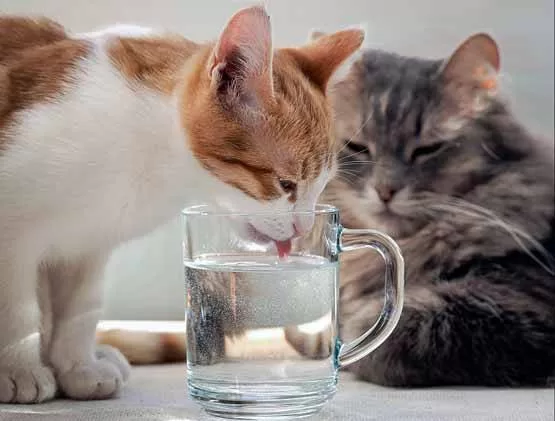
In the wild, cats used to obtain much of their hydration through food, mainly by eating the prey they consumed. Prey, such as rodents and birds, have a significant water content, which largely meets the felines’ hydration needs. However, in domestic environments, where cats are fed industrialized food, it is necessary to encourage water consumption to avoid health problems, such as kidney disease.
Adequate hydration is essential for the functioning of a cat’s body, contributing to kidney health and the proper functioning of the urinary tract.
There are several techniques that can help stimulate hydration in cats. One of them is to use wide water pots, which prevent felines’ sensitive whiskers from being disturbed during ingestion. Additionally, adding wet food to your cat’s diet is an excellent way to provide additional hydration, as well as providing feline health benefits. Spreading pots of water around the house , investing in a running water source and offering fresh, clean water in suitable containers to prevent overheating are also important measures to keep cats adequately hydrated.
In conclusion, understanding the evolutionary history of cats and their hydration strategies in the wild helps us understand why they resist drinking water. Stimulating hydration in these animals is essential to avoid health problems and ensure their well-being. Using different techniques and care, we can ensure that our cats have access to enough water to stay hydrated and healthy.
Why Hydration Is Important for Domestic Cats
Keeping domestic cats adequately hydrated is essential to guarantee their health and prevent diseases, especially those related to the kidneys. Cats have a natural resistance to drinking water, which can lead to dehydration and serious health problems. However, it is possible to stimulate feline hydration by adopting some simple measures.
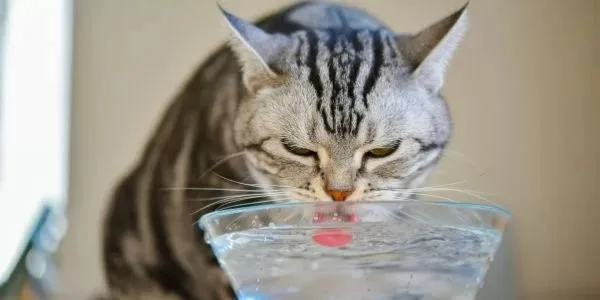
The kidneys play an essential role in a cat’s body, filtering waste and toxins through urine. When cats are not adequately hydrated, their kidneys can become damaged and not function properly. This can lead to the development of kidney disease, which is common in felines. By ensuring your cat is well hydrated, you are helping to prevent kidney problems and promote their overall health.
- Use wide water bowls to prevent your cat’s sensitive whiskers from being disturbed.
- Add wet food to the diet, such as sachets of wet cat food.
- Place bowls of water around the house so your cat has easy access to water in different locations.
- Consider investing in a running water fountain, as many cats are attracted to the movement of water and may drink more.
- Offer fresh, clean water in suitable containers, avoiding overheating of the water.
By following these simple tips, you will be encouraging your cat to stay hydrated and promoting their health and well-being. Remember to regularly monitor your cat’s water intake and consult a veterinarian if you notice any symptoms of dehydration or kidney problems. Take good care of your feline and make sure it is always hydrated!
| Care to encourage hydration in cats | Health benefits for cats |
|---|---|
| Use wide water pots | Prevents discomfort from cats’ sensitive whiskers |
| Add wet foods to the diet | Provides an additional source of hydration and nutrients |
| Spread pots of water around the house | Facilitates access to water in different locations |
| Invest in a running water source | Encourages cats to drink more water |
| Offer fresh, clean water | Promotes health and prevents kidney problems |
Techniques to Stimulate Hydration in Cats
There are several techniques that can be used to stimulate hydration in cats, thus ensuring their well-being and health. Felines have a natural tendency to resist drinking water due to their ancestry and lack of a neural system that makes them feel thirsty. However, it is crucial to keep cats hydrated, especially in domestic environments where they are fed processed food.
One of the important tips is to use wide water bowls, thus preventing cats’ sensitive whiskers from being disturbed. Many cats avoid drinking water from narrow bowls due to the uncomfortable sensation it causes in their whiskers. Therefore, opting for wider pots can encourage water consumption.
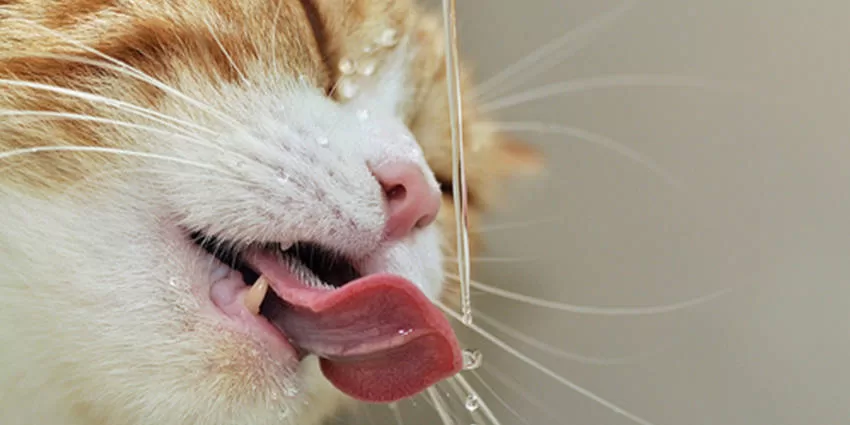
Another effective technique is to add wet food to your cat’s diet. Wet foods, such as pates and sachets, contain a high amount of water, helping to hydrate cats. Furthermore, these foods also promote greater satiety, helping to avoid problems such as obesity.
Furthermore, spreading pots of water around the house is a simple but efficient strategy to encourage hydration in cats. By having easy access to multiple water points, cats are more likely to drink. Placing pots of water in different rooms of the house can be an effective way to encourage water consumption.
| Techniques to Stimulate Hydration in Cats | |
|---|---|
| Use wide water pots | Helps avoid discomfort in cats’ sensitive whiskers. |
| Add wet foods to the diet | Increases water intake and promotes greater satiety. |
| Spread pots of water around the house | Encourages easy access to water in different locations. |
Investing in a running water source can also be an interesting option. Many cats are attracted to the movement of running water and may drink more when they have access to this type of source. Furthermore, offering fresh, clean water in suitable containers that prevent the water from overheating is essential to ensure that cats feel motivated to drink.
In short, encouraging hydration in cats requires a strategic approach. Using techniques such as using wide pots, moist food in the diet, distributing pots of water around the house, investing in running water sources and offering fresh, clean water, we can ensure that our felines are adequately hydrated and enjoying good health. .
Choosing the Right Water Bowls for Cats
Cats have sensitive whiskers and it is important to choose the right water bowls to avoid discomfort and encourage their water consumption. Wide pots are ideal for felines, as they allow them to drink water without their whiskers being disturbed. When whiskers touch the narrow sides of a bowl, cats may feel discomfort and avoid drinking water, which can lead to dehydration problems.
In addition to being wide, cat water bowls must be shallow. This allows the animal to drink the water without having to lower its head too much, making drinking more comfortable. Some wide pots also have sloping edges, which makes accessing water even easier.
Wide, shallow water bowls are an ideal choice to accommodate cats’ sensitive whiskers and ensure they feel comfortable drinking water.
Another interesting option are automatic water fountains that have a water reservoir and a wide bowl for the cat to drink from. These water fountains keep the water fresh and clean for longer, in addition to encouraging the pet to drink water through constant movement.
| Water Pots Suitable for Cats | Characteristics |
|---|---|
| Wide pots | Prevents discomfort from cats’ sensitive whiskers |
| Shallow pots | They facilitate water intake, avoiding excessive effort |
| Pots with sloping edges | Make access to water easier for your cat |
| Automatic drinking fountains | Keep water fresh and moving constantly |
When choosing the right water bowls for your cat, take the animal’s size and height into account. Make sure the pot is always clean and provide fresh water daily. These simple measures will help ensure your cat is hydrated and healthy.
Wet Food in the Cat Diet
Including wet food in your cat’s diet is an effective way to ensure their hydration and offer benefits to their overall health. These foods contain a greater amount of water in their composition, which helps maintain the water balance of the feline organism.
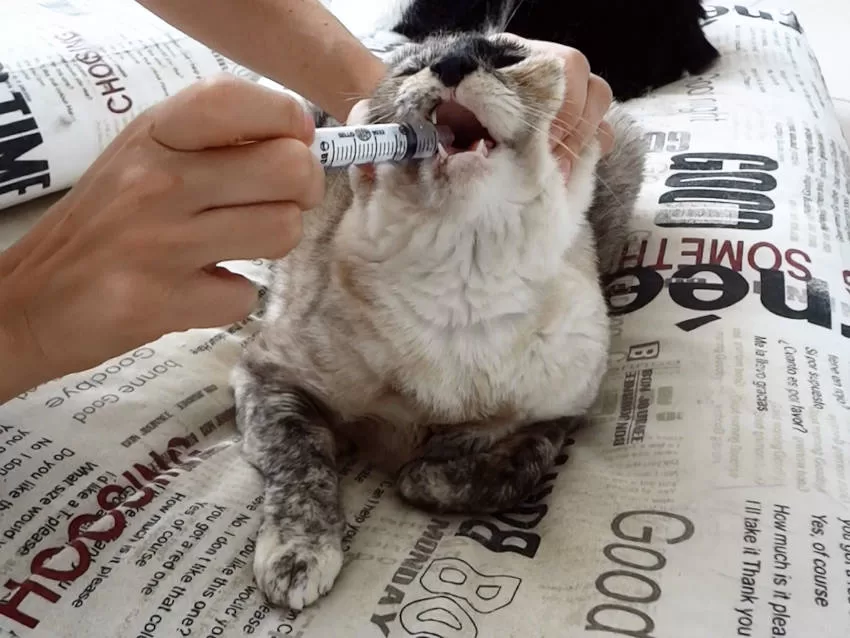
One of the main benefits of including wet food in your cat’s diet is the prevention of kidney problems. Cats that consume a predominantly dry diet are more likely to develop kidney disease, as a lack of adequate hydration can overload the kidneys and affect their proper functioning.
Furthermore, the moisture present in wet food helps maintain the health of cats’ urinary tract, preventing infections and the formation of kidney stones. These foods also contribute to the health of the skin and coat, providing internal hydration that is reflected externally.
| Benefits of Wet Food for Cats |
|---|
| Ensure adequate hydration |
| Prevent kidney problems |
| Maintain urinary tract health |
| Contribute to skin and coat health |
To include wet food in your cat’s diet, you can opt for canned food or sachets specifically for felines. Make sure you choose quality products, rich in nutrients essential for your pet’s health. Consult a veterinarian for appropriate guidance on the quantity and frequency of consumption of these foods according to your cat’s individual needs.
Spreading Pots of Water Around the House
Spreading pots of water around the house is an efficient strategy to encourage cats to stay hydrated throughout the day. Felines have a natural tendency to drink water in different locations, and having pots of water distributed in various parts of the house can increase the opportunity for water consumption.
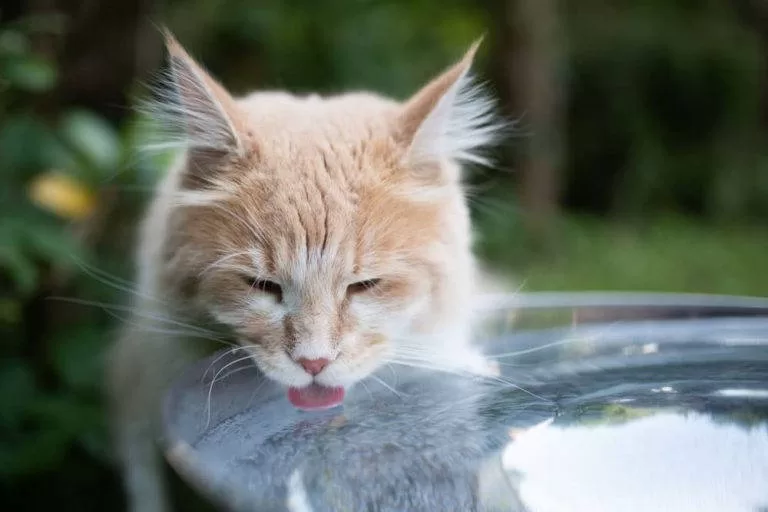
One way to implement this strategy is to place bowls of water in areas where the cat spends a lot of time, such as where it usually eats, rests or plays. This way, he will have easy access to water and will be reminded to drink it during his daily activities.
Furthermore, it is important to offer pots of fresh, clean water in every part of the house. Cats are demanding animals and may not drink water if they notice it is dirty or has a bad smell. Therefore, make sure to change the water regularly and wash the pots frequently to ensure the quality of the water provided to your felines.
Advantages of spreading pots of water around the house:
- Stimulates water consumption by providing easy access in different locations.
- Prevents dehydration, especially in cats that are predisposed to drinking less water.
- Avoid competitions between cats for a single bowl of water.
- Promotes kidney health by ensuring adequate hydration.
When adopting this strategy, it is important to observe your cat’s behavior and make sure it is drinking water regularly. If there is any change in the water consumption pattern or if you suspect dehydration, it is recommended to consult a veterinarian for a proper evaluation.
| Benefits | How to implement |
|---|---|
| Stimulates water consumption | Place pots of water in strategic areas of the house |
| Dehydration prevention | Offer pots of fresh, clean water at all points |
| Prevents competition between cats | Have multiple water bowls for each cat |
| Promotes kidney health | Ensure adequate hydration throughout the day |
Investing in Running Water Sources
Running water fountains are an attractive option for encouraging hydration in cats, as they mimic the natural flow of water they would find in nature. Cats are attracted to the movement of water, and fountains provide this continuously, encouraging them to drink more water throughout the day. Furthermore, running water is fresher and more oxygenated, which may be more attractive to felines who are picky about water quality.
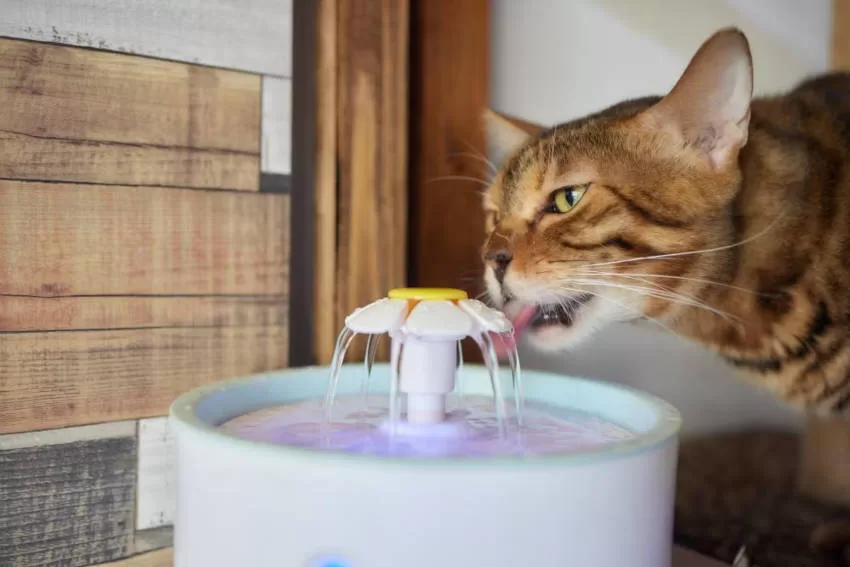
Purchasing a running water source for your cat is a smart decision to promote their health and well-being. There are several options available on the market, from simple fountains with a constant flow to more advanced models with different flow settings and water filters.
It is important to choose a running water source that is suitable for your cat. Consider the size of the container to ensure there is enough water for the container’s daily consumption. Also, take into account the ease of cleaning the fountain, as the water must be changed and the equipment sanitized regularly to prevent the accumulation of bacteria.
By installing a running water fountain, you will be providing your cat with an attractive and healthy alternative to staying hydrated. Remember that each cat is unique, and you may need to experiment with different types of fonts to find the one that best suits your feline’s preferences. Always keep water fresh and clean, encouraging him to drink regularly to avoid health problems associated with dehydration.
Offering Fresh, Clean Water
Ensuring that cats have access to fresh, clean water is essential to encourage adequate hydration and prevent health problems. Although cats seem to be picky when it comes to water, there are some simple steps you can take to ensure they get the ideal amount of hydration.
One of the important aspects to consider is the water container used. Choose wide pots that prevent cats’ sensitive whiskers from being disturbed during consumption. This will ensure they feel more comfortable drinking water and can hydrate properly.
Additionally, including wet food in your cat’s diet can be a great way to ensure your cat is getting enough water. Wet foods, such as sachets and pâtés, have a high water content and can help increase feline hydration. Consult a veterinarian for guidance on how to properly incorporate wet food into your cat’s diet.
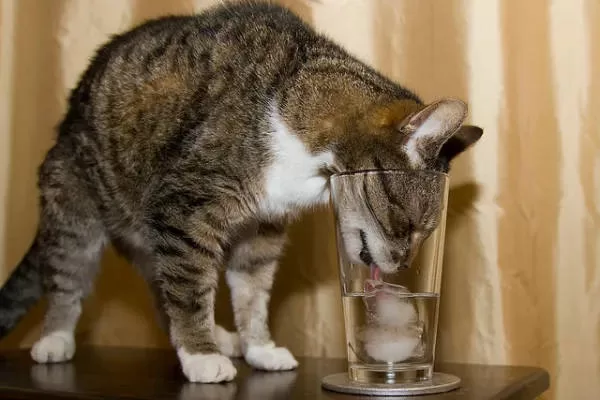
Another effective strategy is to spread pots of water around the house. Place extra pots in different rooms so that access to water is easier for the cat. This will encourage regular drinking as cats will have the option to drink water from locations closer to them.
Investing in a source of running water can also be an excellent way to encourage hydration in cats. Many felines are attracted to moving water, and a running water fountain may pique their interest in drinking more water. There are several fountain options available on the market to suit cats’ individual preferences.
Additionally, always offer fresh, clean water in suitable containers. Avoid using plastic containers as they can trap residue and bacteria. Opt for stainless steel or ceramic bowls, which are easy to clean and don’t accumulate odors. Regularly check that the water is fresh and, on hot days, avoid exposing the water to the sun to avoid overheating.
Now that you know how to offer fresh, clean water to cats and encourage adequate hydration, remember to apply these tips to your daily routine. By keeping your cats hydrated, you will be providing them with long-term health and well-being.
FAQ
Q: Why do cats resist drinking water?
A: Cats resist drinking water mainly due to their ancestry and lack of a neural system that induces the sensation of thirst. They used to obtain hydration through food, such as the prey they consumed.
Q: Why is it important to encourage hydration in cats?
A: It is important to encourage cats to stay hydrated to avoid health problems, such as kidney disease, especially in domestic environments where they are fed processed food.
Q: How to encourage hydration in cats?
A: Some effective techniques for encouraging hydration in cats include using large water bowls to keep their sensitive whiskers from being disturbed, adding wet food to their diet, placing bowls of water around the house, investing in a running water source, and offer fresh, clean water in containers that prevent overheating.
Q: How to choose suitable water bowls for cats?
A: It is important to choose wide water bowls for cats, preventing their sensitive whiskers from being disturbed and making it easier for them to drink water.
Q: How important is it to include wet food in a cat’s diet?
A: Including wet food in a cat’s diet is important to ensure adequate hydration, as well as bringing benefits to feline health.
Q: How can you place bowls of water around the house to encourage cats to stay hydrated?
A: Spreading bowls of water around the house is a practical strategy to encourage hydration in cats, providing easy access to water in different locations.
Q: Why invest in running water fountains for cats?
A: Investing in running water sources is beneficial to encourage hydration in cats, as these devices can attract felines to drink water in a more natural way.
Q: How to offer fresh, clean water to cats?
A: It is important to offer fresh, clean water to cats, using suitable containers that prevent the water from overheating.
Source Links
- https://www.correiobraziliense.com.br/revista-do-correio/2020/08/4870170-felinos-nutridos-e-hidradados.html
- https://www.petz.com.br/blog/pets/gatos/gato-nao-bebe-agua/
- https://bbifiltracao.com.br/como-e-por-que-estimular-seu-pet-a-beber-mais-agua/

